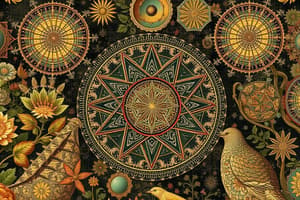Podcast
Questions and Answers
Which of the following statements accurately describes the relationship between the branches of mathematics?
Which of the following statements accurately describes the relationship between the branches of mathematics?
- Discrete mathematics does not utilize any concepts from set theory.
- Algebra is strictly unrelated to arithmetic.
- Calculus and statistics are both applied mathematics branches. (correct)
- Geometry solely focuses on the study of prime numbers.
Which of the following correctly describes the different types of numbers in the number system?
Which of the following correctly describes the different types of numbers in the number system?
- Complex numbers do not include real numbers.
- Natural numbers and whole numbers are the same.
- All integers are also rational numbers. (correct)
- Irrational numbers can always be expressed as a ratio of integers.
Which operation can be defined as finding the difference between two quantities?
Which operation can be defined as finding the difference between two quantities?
- Addition
- Subtraction (correct)
- Multiplication
- Division
Which of the following best describes a function?
Which of the following best describes a function?
Which proof technique is specifically used to establish the validity of a mathematical assertion through contradiction?
Which proof technique is specifically used to establish the validity of a mathematical assertion through contradiction?
Flashcards
Algebra
Algebra
Extends arithmetic by using variables to represent unknown quantities and solve equations.
Functions
Functions
A relationship where each input corresponds to exactly one output.
Natural Numbers
Natural Numbers
The set of counting numbers (1, 2, 3, ...).
Sets
Sets
Signup and view all the flashcards
Subtraction
Subtraction
Signup and view all the flashcards
Study Notes
Branches of Mathematics
- Mathematics is a broad field encompassing various branches, each with distinct focus areas.
- Arithmetic deals with fundamental operations like addition, subtraction, multiplication, and division of numbers.
- Algebra extends arithmetic by using variables to represent unknown quantities and solve equations.
- Geometry studies shapes, sizes, and positions of objects in space.
- Calculus involves concepts like limits, derivatives, and integrals, used to analyze continuous change.
- Statistics deals with collecting, analyzing, and interpreting data.
- Probability analyzes the likelihood of events occurring.
- Number theory studies properties of numbers, such as prime and composite numbers.
- Discrete mathematics deals with objects that can be counted, such as graphs and algorithms.
- Applied mathematics applies mathematical theories and methods to solve real-world problems in various fields.
Fundamental Concepts
- Sets: Collections of objects. Elements are members of sets. Set theory defines operations like union, intersection, and complements.
- Logic: Deals with reasoning and arguments using statements that are either true or false. Fundamental logical concepts include conjunction, disjunction, implication, and negation.
- Functions: A relationship between two sets where each element of the first set is associated with exactly one element of the second set.
- Relations: A connection or relationship between elements of a set or between sets. Types include equivalence, order, and partial order relations.
- Proof Techniques: Mathematical arguments used to demonstrate the truth of a statement. Common methods include direct proof, proof by contradiction, mathematical induction, and proof by cases.
Number Systems
- Natural numbers (counting numbers): 1, 2, 3, ...
- Whole numbers: 0, 1, 2, ...
- Integers: ..., -3, -2, -1, 0, 1, 2, 3, ...
- Rational numbers: Numbers that can be expressed as a ratio of two integers (e.g., 1/2, 3/4).
- Irrational numbers: Numbers that cannot be expressed as a ratio of two integers (e.g., √2, π).
- Real numbers: Include both rational and irrational numbers.
- Complex numbers: Extend the real number system by including imaginary numbers (√-1).
Basic Operations
- Addition (+): Combining two or more quantities.
- Subtraction (-): Finding the difference between two quantities.
- Multiplication (×): Repeated addition of a quantity.
- Division (/): Finding how many times one quantity is contained within another.
- Exponents: Repeated multiplication of a number (e.g., 23 = 2 × 2 × 2).
Equations and Inequalities
- Equations: Statements that show that two expressions are equal.
- Inequalities: Statements that show that two expressions are not equal (e.g., <, >, ≤, ≥).
- Solving equations: Finding the values of variables that satisfy the equation.
- Solving inequalities: Finding the ranges of values that satisfy the inequality.
Geometry
- Points, lines, planes: Fundamental geometric objects. Lines and planes can be described by equations.
- Angles: Formed by two rays sharing a common endpoint.
- Polygons: Closed figures formed by line segments (e.g., triangles, quadrilaterals).
- Circles: Defined by a center and radius.
- Solids: Three-dimensional shapes (e.g., cubes, spheres).
Data Analysis
- Collecting data: Gathering information about a topic or population.
- Organizing data: Arranging data in tables, charts, or graphs.
- Analyzing data: Examining data to identify trends, patterns, or relationships.
- Interpreting data: Drawing conclusions and making inferences based on the analysis.
Problem Solving
- Understanding the problem: Deconstructing the problem to identify known and unknown information.
- Developing a strategy: Choosing an appropriate approach or method to solve the problem.
- Implementing the strategy: Performing the necessary calculations or steps.
- Evaluating the solution: Verifying the correctness and reasonableness of the result.
Studying That Suits You
Use AI to generate personalized quizzes and flashcards to suit your learning preferences.
Description
Explore the various branches of mathematics, including arithmetic, algebra, geometry, calculus, statistics, and more. Each branch plays a crucial role in understanding different mathematical concepts and real-world applications. Test your knowledge of these fundamental areas in this engaging quiz!




